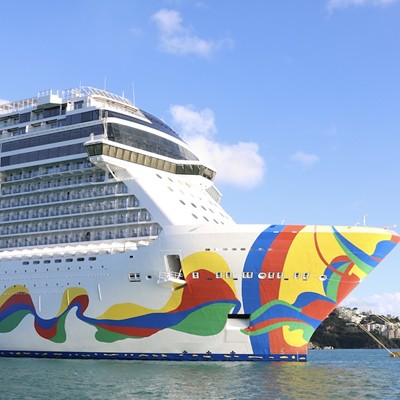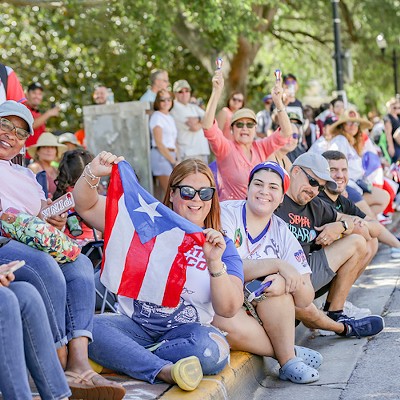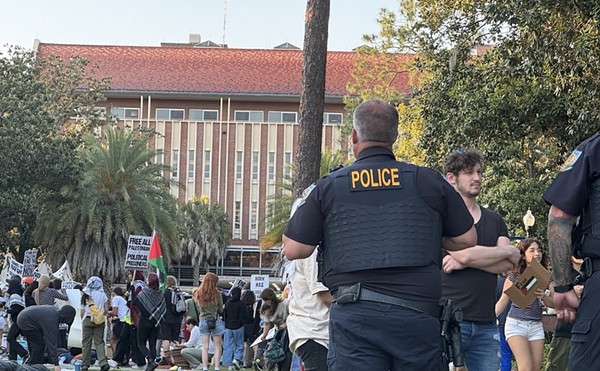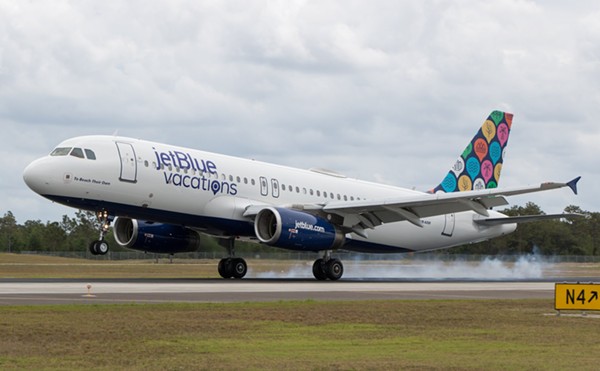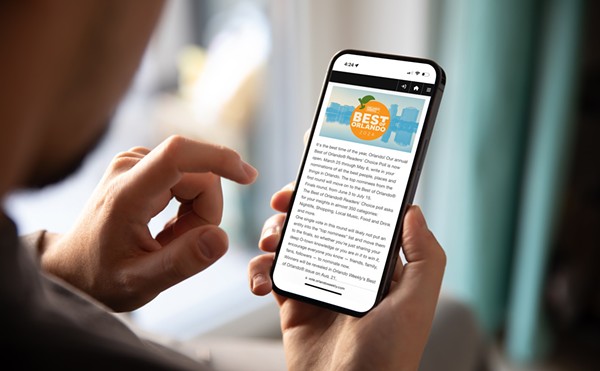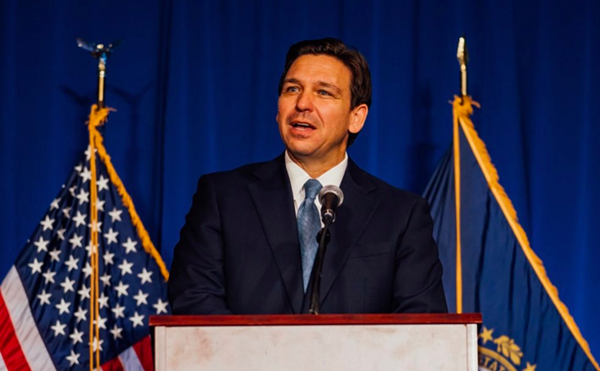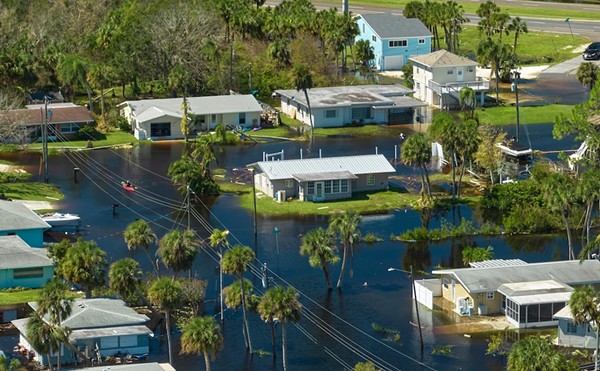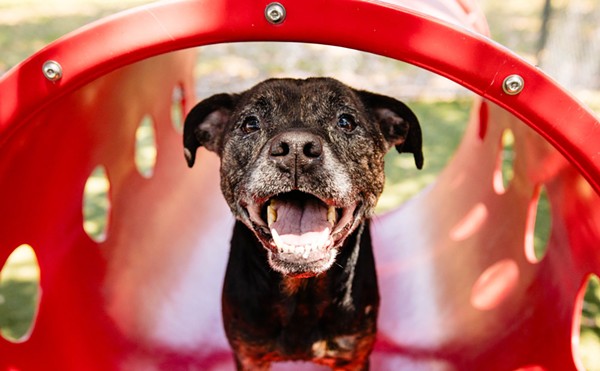It's 6:15 a.m., Nov. 20, and cold -- or at least, as cold as November mornings in Orlando get. The temperature has dipped into the low 50s, and we're standing in the parking lot of the University of Central Florida Arena, anxiously awaiting the warmth of a chartered bus due here 45 minutes ago. With me is a writer from the Central Florida Future, about 35 student activists from the school's campus.Peace.ACTION group and two older women sporting Dennis Kucinich T-shirts.
"Lousy union labor!" one student yells, a reference to the missing bus. He's shot a look of remonstration, and recants: "I'm just joshing."
We're not the only ones growing impatient. Channel 13 sent a reporter out to film the students getting on the bus, and she's now behind schedule. While we wait, ACTION leader Emily Ruff passes around a release form that includes a space for next of kin.
"What's it for?" one student asks.
"If you get arrested," Ruff responds.
"Not if, when," another student chimes in, and the group laughs.
Ruff instructs us to break into groups of two or three -- the buddy system -- and gives us gauze, bandages and latex gloves. One student activist is commended for having a poster that's not attached to a carrying stick: Sticks can be considered weapons, I'm told, and where we're going, having such a weapon could get you beaten or tear-gassed. Another student uses red tape to fashion a cross on the front and back of his white sweater. He will be the group medic.
If all this sounds a little melodramatic, it is. Then again, our destination, Miami, is a war zone. Thousands of cops are on hand to prevent disruption of the Free Trade Area of the Americas talks currently underway in a downtown Miami hotel. The city has set its jaw, and will not allow a repeat of the anarchy that occurred in Seattle in 1999, when an anti-World Trade Organization protest morphed into a riot that devastated the city. Miami cops, the activists tell me, are authorized to use lethal force.
Tens of thousands of activists, including us, will converge on the city to protest the FTAA, an agreement between 34 nations to allow unrestricted trade throughout the hemisphere, minus Cuba. Critics have dubbed the FTAA "NAFTA on steroids."
Antiglobalization activists believe free trade doesn't mean fair trade. To save production costs, big companies shift manufacturing jobs to poor countries, where they can pay low wages and boost profit margins while bypassing the costly environmental regulations of developed countries. While free trade does mean cheaper goods, critics say, NAFTA has also cost America three million manufacturing jobs and a skyrocketing trade deficit.
Already, there have been skirmishes down south. On Nov. 17, small groups of activists passing out anti-FTAA literature were surrounded by cops, grilled about their plans and ordered to produce ID. On Nov. 18, the city's bomb squad detonated two "suspicious packages," though neither turned out to be dangerous.
A little after 6:30 a.m., with the sunrise in the east cutting into the morning's brisk cold, the bus finally pulls up, and we're away.
8:37 a.m.
Ruff brought two videos to pass the four-and-a-half-hour ride: Michael Moore's "The Big One" and a low-res, yet interesting documentary called "The Hemp Revolution." I'm glancing back and forth between the September issue of Atlantic Monthly and the 10-inch television at the front of the bus when Ruff plops into the empty seat next to me. We should chat now, she says, because she's been up all night and really needs a nap. She's going to spend the night in Miami, in case someone ends up hurt or in jail, and also there are some extra meetings, so she won't be on the bus ride home.
Ruff, 22, is a tall, thin senior with short blond hair and a long gray skirt who is majoring in philosophy and co-chairs UCF's increasingly prestigious Progressive Council. She is pleasant but businesslike, and surprisingly adept, given her age, at giving interviews. She speaks passionately, but doesn't ramble or allow herself to stray off-topic.
I ask her about the turnout. It wasn't so long ago that UCF was a remarkably apolitical institution, and stirring student interest in something like this would have been impossible.
"I'm definitely surprised," she says. "The FTAA is such a complex issue to address, particularly to students. We've come at it from a lot of different angles."
That included bringing in speakers to talk about free trade's relationship to the drug war, and attempting to rally older suburbanites by pointing out that free trade induces illegal aliens to cross the border. Overall, though, she boils it down to "the overwhelming amount of human loss -- humanity, really. Lives are being stolen in Central America. It's a Goliath."
She tells me she's not sure what to expect today. A group called No Borders, No Fences, No Occupation had an "action" planned for 7 a.m., but she hasn't heard what became of it, if anything. She's also worried that police intimidation may dampen the crowd's enthusiasm: A few nights ago, she tells me, an organizer was in a bar with about eight other drinkers a few minutes past the 2 a.m. cutoff time. Cops came in and arrested the organizer only.
11:14 a.m.
Miami is closed for business. We are supposed to find our way downtown, but the exit off I-95 is blocked. Johnny, our bus driver, asks if anyone knows another route. One student walks up from the back of the bus and offers a suggestion, but the alternate route is also blocked. Twenty minutes later, we find our 50-seater winding through the narrow one-way streets of Little Havana, unable to scout an open path into the heart of Miami, where the march is set to begin in two hours.
Johnny asks a cop manning a barricade for directions. He says there is no way we are getting any closer to downtown and that we should unload right where we are. It's about a mile hike, but it's the best we're going to do.
As I walk, I count six helicopters circling downtown. Most are from news organizations. A UCF student points one out: a Black Hawk military chopper.
Miami is surreal. There are no cars, and only a handful of pedestrians. Storefronts are boarded up and shut down. Very few businesses are open; those that are remain empty.
And there are cops everywhere. We cross a bridge to find about 70 of them in a parking lot full of police squad cars and motorcycles. One is taking pictures of us with a digital camera as we pass.
We arrive at an intersection and find a wall of cops in riot gear, brandishing batons and pellet guns. There are maybe 50 of them, standing shoulder-to-shoulder two layers deep, cordoning off an entire city block and directing us along the designated route.
With every new intersection comes the same scene. One group of cops is seated atop an idling Humvee. Another group seems a little more upbeat than the rest, not like they're expecting a repeat of Seattle any minute now. When stray protestors take pictures of this group, they hold up disposable cameras and snap right back. When I shoot a photo, an officer pretends to model. "Can you get my good side?"
12:23 p.m.
"I'm scared," says Joslyn Smith, a bespectacled young lady in a dark sweater and jeans.
The scene outside the Bayfront Park amphitheater isn't dangerous. Just disorganized. There's a rally going on inside the amphitheater, but the place is full. So our lot is to mill about outside where there are no bathrooms and nothing to eat. (There are portable toilets near the amphitheater, but those are for the cops.)
Smith is scared of losing her "buddy," Matt de Vlieger, a thin, black-clad, class-clown type who refers to me the entire day as "journalist" or "press." He is nearby, socializing with other students. There will be a dozen of these momentary panics today, as it's quite easy to lose track of your friends in this sea of humanity.
No one's sure what we're supposed to be doing. One guy passes us a petition for a constitutional amendment to raise the minimum wage in Florida. Others beat on drums. A dreadlocked few try their hand -- or feet -- at interpretive dance.
There are a million causes represented here: unions, hippies, commies, tree-huggers, peaceniks, feminists, animal rights and anarchists, to name a few. There are also, obviously, some people here to protest just for the sake of protesting, maybe to raise a little hell.
Word comes through the crowd that the march will begin at 1:30 p.m., and circle the deserted streets of Miami's core. If there is to be a Seattle redux, that will be the time.
12:46 p.m.
The crowd is getting restless, and so are the cops. Even in November, the midday temperatures are pushing into the 80s, and being blanketed in riot gear and forced to stand in one spot all day long can hardly be comfortable. Some police look like they're ready to bash heads.
Suddenly, scores of people start moving toward the line of cops barricading the eastern edge of our assigned parking lot. As a reporter I'm ready to see something -- a little tear gas, a few beat-downs, some pellet guns in use, whatever. I didn't ride all the way down here to stand in a parking lot.
But the rush is a nonevent. A woman is standing in front of the cops, yelling about something. A crowd of maybe 100 has surrounded her. The cops look like they couldn't care less.
Walking back to my own group, I'm amused by the Telemundo reporter interviewing a random activist. Not by the interview itself, which I can't hear, but by the fact that the reporter looks like he's in a war zone, sporting the same riot gear as the cops.
He's "embedded" in Miami. So are lots of reporters. Throughout the day I spot dozens of journalists, from local television reporters to writers from the Miami Herald, trussed up in helmets and bulletproof vests to interview the scary activists.
1:09 p.m.
Our two major problems -- a lack of food and bathroom facilities -- are both solved within 15 minutes. A thoughtful group of activists brought vegan pasta salad for everyone, or at least those who could grab some before supplies ran out. Problem was, however, there weren't enough plastic forks to go around, so I was stuck trying to slurp my pasta salad hands-free. It didn't work so well.
Which presents another problem: There are no trash cans.
On the restroom issue, word comes that a Miami Subs a few blocks away is open and allowing protestors to use their restrooms. Not surprisingly, then, the sub shop has become something of a haven for the hired and tired. About a dozen activists are sleeping outside the store. Inside, more than two dozen are in line waiting for food, and a dozen more are lined up for the bathrooms.
The sign on the front door says, "Restrooms for customers ONLY!" But in the confusion, how will they really know?
1:38 p.m.
The march is finally about to get under way. The amphitheater is slowly starting to empty, and a group of yellow-shirted steelworkers take positions at what will be the front of the procession. The AFL-CIO goes first, we're told, and other groups have to fall in line.
The AFL-CIO is not only image-conscious, but painstakingly detail-oriented. They have their own barricade of "peacekeepers" to run interference between protestors and cops. They also have "legal observers" that will line the march route to intervene in protestor-cop melees.
Off we go, though we have to wait for thousands of union workers, Sierra Clubbers, and even a flock of Minnesotans wearing green "Wellstone" T-shirts (members of the Wellstone Action Network, a political advocacy group named after the late senator) to pass before we can join in. The official count, I'm later told, is 10,000, but that seems a bit low to me. The procession wraps all the way around downtown, covering blocks upon blocks upon blocks, the streets packed wall-to-wall with protestors.
It's a two-and-a-half mile march. And since I'm still dressed in the black sweatshirt and jeans that I thought were a good idea when I woke up this morning, it's starting to feel a little muggy.
"Hey hey ho ho, the FTAA has got to go!" is the afternoon's most popular chant. "FTAA, go the fuck away!", though championed by our group, doesn't catch on so well. A little later, Twisted Sister's chorus of "We're not gonna take it!" becomes the fad.
One memorable moment: The union workers in front of us paused at an intersection, and in one proud voice, shouted, "We are the union!"
"How can that not give you chills?" a young lady beside me asks.
We're halfway through the march, and nothing untoward has happened yet. The multitudes of cops we pass still eye us suspiciously, but as the day moves on without incident, their glances soften.
I overhear a blond, long-haired activist tell his friend, "It's going to get crazy at five. I've heard they're going to topple the fences at five."
While we march, the FTAA talks are underway in the heavily blockaded Inter-Continental Hotel. Today, a day earlier than expected, trade ministers arrived at a loosely knit agreement, skimming over the thorny issue of U.S. agricultural subsidies. There's a bit of irony here. Miami is angling to be the FTAA's secretariat, but at the same time Florida is fighting tooth and nail to maintain its protectionism of the citrus industry.
Without those subsidies, Florida's citrus industry would suffer, as South American countries could likely underprice the state's second-largest industry and cut deeply into profits.
So Florida is all for free trade, when convenient. Florida hasn't suffered as much as states that rely more heavily on manufacturing. Of the 3 million jobs critics estimate the United States has lost after NAFTA, just shy of 12,000 came from Florida, according to Public Citizen's database. To date, then, the state has mainly reaped the benefits of trade, via cheaper goods, and hasn't felt its downside. If the U.S. loses its ability to subsidize agriculture in the FTAA, however, we'll feel it big time.
It turns out that Thursday wasn't as peaceful as I thought. In the morning before we arrived and in the evening after we left, groups of protestors stormed the hotel's gates, according to news accounts, and were repelled with tear gas and batons. Nothing major, but still the type of stuff that makes headlines and leads the 11 o'clock news and, perhaps, gives viewers a false impression about what the protestors, who crossed racial, political and social lines, were all about.
2:40 p.m.
When the march ends, the AFL-CIO workers pack back into the amphitheater, and we're stuck outside again, with about an hour to kill before our rendezvous with the bus that dropped us off five hours earlier. Most of the UCF students rest on the pavement, take aspirin for the headaches, smoke cigarettes and talk.
At 3:45 p.m., we begin our trek back to the bus, which is late. As we try to navigate Miami's downtown, there's an oddly picturesque moment. On the stairs of a Catholic church, 40 exhausted cops are lying on their backs, still attired in riot gear. The streets are empty. The shops are all closed.
If I didn't know better, it would look apocalyptic. But the rumors of this war zone had been greatly exaggerated.


